Starbucks Queens Plaza Brisbane: Marketing Strategy Evaluation and Recommendations
Info: 8898 words (36 pages) Dissertation
Published: 20th Dec 2021
Tagged: MarketingBusiness Strategy
Executive Summary
The remarkable growth and expansion of Starbucks has been on both a global scale and within Australia. However, the closure of three-quarters of Starbucks’s Australian operations in mid-2008 poses the need to explore this further. This report will apply the 8 Ps of the marketing mix – product, price, place, promotion, processes, physical evidence, people and partnerships – to the Starbucks Queens Plaza Store (Brisbane City) and evaluate the effectiveness of the store’s marketing mix. Marketing mix evaluation has found that Starbucks operations in Australia is vastly different to its US counterparts – it is overvaluing their points of differentiation and the perceived value of their supplementary services (“Starbucks Experience), particularly relative to the prestige pricing of their products; their service standards are average and easily imitable; and they are not effectively communicating their brand. It is recommended that the coffee chain gain a deeper understanding of the Australian coffee culture and consequently tailor its operations and extended marketing mix to the unique Australian context; and even consider. Once these product and service attributes are determined, the coffee chain is able to build brand awareness and loyalty, increase its sales, and ultimately, achieve its corporate objectives in Australia.
Table of Contents
1. Introduction
1.1 Company
1.2 Location
1.3. Consumer
2. Analysis – 8 Ps of Marketing
2.1 Product
2.2 Price
2.3 Place
2.4 Promotion
2.5 Physical Evidence
2.6 Processes
2.7 People
2.8 Partnerships
3. Recommendations
4. Conclusion
5. References
1. Introduction
1.1 Company
Founded in 1971 in Seattle, Starbucks Corporation is an American coffee chain that roasts and sells high-quality coffees, along with handcrafted coffee, tea and other beverages and food items through company-operated and licensed stores worldwide (Starbucks, 2017, p. 2). Starbucks first opened in Australia in July 2000, initially with 81 stores before closing underperforming stores in 2008 and leaving only 34 stores across Sydney, Melbourne, Brisbane and Gold Coast (Starbucks, 2018f; Patterson, Scott & Uncles, 2010; Vuong, 2018). In May 2014, the Withers Group (the local owner of 7-Eleven) acquired the Australian rights to Starbucks, with expansion plans across Australia (Vuong, 2018).
1.2 Location
This report will focus on the Starbucks coffee shop located in the upscale shopping centre, Queens Plaza, in the Brisbane CBD. The store is positioned at the entrance of Queens Plaza on Adelaide Street, with entrances both from the Adelaide Street side and from inside the shopping plaza.
1.3. Consumer
The university students that frequent the Starbucks location in Queens Plaza, will be the basis of the analysis in the subsequent sections.
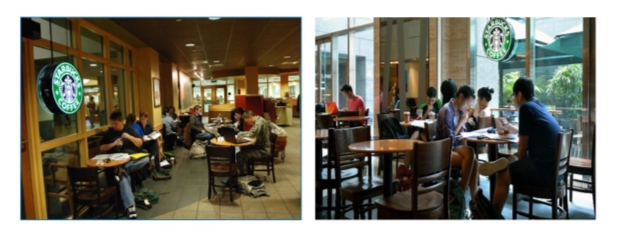
Figure 1: University students at a Starbucks store
2. Analysis – 8 Ps of Marketing
2.1 Product
A product is a good, a service or an idea received in an exchange and can be tangible and/or intangible and can include functional, social and psychological benefits (Pride et al., 2018). A product’s total offering has three interdependent elements – the core product itself, its supplemental features and its symbolic or experiential benefits (Pride et al., 2018). At Starbucks, the core products are handcrafted hot and cold beverages and food, packaged coffee, and merchandise; and the supplemental features and experiential benefits can be related to the “Starbucks Experience” which is built on high quality and ethically sourced product offerings; customer service; seamless digital experience and store ambience and layout (Starbucks, 2017; Starbucks, 2018g).
There are two main product categories – consumer or business products. Starbucks products are consumer goods, thereby falling into the “convenience products” category as coffee is relatively inexpensive, frequently purchased and with minimal purchasing effort (Pride et al., 2018). The company’s Product Mix, which are the total group of products a company makes available to customers (or the combination of all product lines) (Pride et al., 2018), are exhibited on Appendix A. A subset of the product mix, a Product Line, refers to a group or set of closely related products that are considered to be a unit because of marketing, technical or end-use consideration (Pride et al., 2018). Accordingly, Starbucks offers the following range of products or product lines that customers can enjoy in-store, at home, and on the go – all of which are responsibly grown and sourced ethically and ethically traded (Starbucks, 2018b, 2018d):
- Coffee & Espresso
- Tea & Chocolate beverages
- Iced Beverages
- Frappuccino Blended Coffee
- Frappuccino Blended Cream
- Bakery & Pastries
- Cakes & Slices
- Sandwiches & Wraps
- Savoury Bites
- Merchandise (mugs, packaged coffee, etc.)
It is evident that despite the large product mix offered by Starbucks, the coffee and espresso product line for example, is the same as other coffee shop offerings, such as the Queens Plaza store’s competitor – Noosa Chocolate Factory – therefore, offering very little differentiation at that level (Zomato, n.d.). Further, comparison with Starbucks US’s product mix reveals that Starbucks Australia has a far smaller and simpler mix – Starbucks US has a broader product line to target different market segments, offering beverage lines like its Starbucks Refreshers consisting of iced cold drinks (Starbucks US, 2018a, 2018b).
Being in the Café and Coffee Shop Industry in Australia, Starbucks is in the growth stage of the industry life cycle, with the industry anticipated to reach maturity in the next 5 years (Vuong, 2018). At the growth stage, the number of businesses and products sold by the industry is rising, the sale curve peaks and starts to decline as profits fall (Pride et al., 2018; Vuong, 2018). Represented on the Product Life Cycle graph, Starbucks’s coffee would be mapped accordingly:
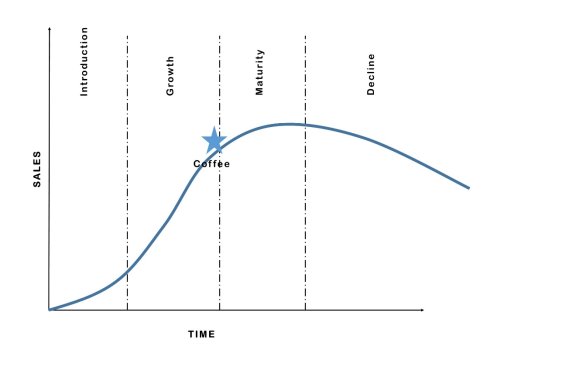
Figure 2 Industry / Product Life Cycle for Coffee
Hence, there is more pressure on Starbucks to focus on its products in terms of produce offerings and development to meet the constant change in consumer tastes and preferences and to differentiate itself from competitors. This is particularly important given that Starbucks occupies less than 1% of industry market share in an industry already progressing towards maturity (Vuong, 2018). This also means focusing on improving the quality of its coffee because in recent years, establishing product quality has been challenging for Starbucks. According to Pride et al (2018) and Wang (2013), product quality refers to the characteristics of a product that allow it to perform as expected and satisfy the customer and whereby consumer-perceived product quality is the consumer judgment of the overall excellence or superiority of a product. Patterson, Scott & Uncles (2010) suggest that the cause of Starbucks Australia’s initial demise around 2008 was because Australians had found Starbucks coffee to be gimmicky and of inferior quality and tasting bitter; watered-down with lots of milk and syrup. Australians, unlike American or Asian consumers, have a sophisticated coffee palate, preferring their coffee straighter and stronger, and without additional syrup flavouring (Patterson, Scott & Uncles, 2010). Therefore, the consumer perception of poor quality not only demonstrates the importance of understanding the local coffee culture and providing a coffee experience that meets with consumer preferences but also portrays the coffee chain’s failure to provide the “Starbuck Experience” to Australian consumers. In essence, a company’s products are the starting point to creating value for customers – if they are high quality products that meet customer need, then Starbucks is able to increase brand loyalty, customer patronage and sales.
2.2 Price
Starbucks engages in non-price competition, which emphasises product differentiation through distinctive features, services, product quality or other factors (Pride et al., 2018). The coffee chain’s pricing objective, which are goals that describe what a company wants to achieve through pricing, is to maximise its profit (Pride et al., 2018; Starbucks, 2017). A pricing strategy is a course of action designed to achieve these pricing objectives and, in this case, Starbucks engages in a prestige pricing strategy, in which prices are set at a high level for a product in order to convey superior quality or a prestige image (Pride et al., 2018). The coffee chain justifies its high prices in exchange for them providing customers the “Starbucks Experience” underpinned by high quality and ethically sourced coffees in an ambient environment with superior customer service even though they could probably buy similar if not even greater quality coffee from competing coffee shops for a fraction of the price (Patterson, Scott & Uncles, 2010; Vuong, 2018). Thus, not only does prestige pricing enable Starbucks to meet its pricing objective, higher prices also communicate to consumers the high quality associated with the coffee chain’s product offerings (perceived or real) and helps position itself as a high-end coffee shop relative to competitors in the marketplace (Dodds, Monroe and Grewal, 2018; Vuong, 2018). In the US, this is very much true – Patterson, Scott and Uncles (2010) state that in the US Starbucks has differentiated its brand by creating a unique store atmosphere – people loyally patronise Starbucks for the experience as much as they go for the product and are therefore less sensitive to price d. It has become a symbol status for many US citizens.
However, in Australia, this proves to be different – Australian customers are questioning whether the premium price is justifiable given that they can easily receive the same in-store experience and superior quality coffee from competitors (Patterson, Scott & Uncles, 2010). Customer interpretations of and responses to such high prices for convenience goods is determined to some degree by their assessment of value (benefits, attributes, advantages and disadvantages, status etc.) associated with the product (Pride et., al 2018).
Therefore, although Starbucks’s price marketing mix reflects the company’s goal of profit maximisation and desired positioning as a luxury coffee shop relative to competitors – their pricing strategy is ineffective in the Australian market because customers perceive their product and service offerings to be undifferentiated and of inferior quality, and thus, cannot justify its high prices.
2.3 Place
A marketing channel, or channel of distribution, is a group of “individuals and organisations that direct the flow of products from producers to customers” (Pride et al., 2018, p. 430). In the US, Starbucks uses a hybrid marketing channel for the distribution of its products, which is a combination of direct and indirect channels to reach the same target market segment (Pride et al., 2018). In an effort to control quality, compliance with coffee standards and ensure ethical sourcing practices are followed, the coffee chain controls coffee purchasing, roasting and packaging and the global distribution of coffee used in its operations (Starbucks, 2017). Starbucks purchases its coffee beans from multiple coffee-producing regions around the world such as Latin America, Africa and Asia, custom roasts them to the company’s standards and then sells its products directly through its company-owned and licensed stores, as well as selling engaging in distribution agreements with US supermarkets, office coffee suppliers, hotels, and airlines (Starbucks, 2017). However, in Australia, the channel of distribution is simpler, with the coffee chain employing a direct marketing channel, owned and managed by the company itself to supply the market directly through its company-owned and licensed stores (Pride et al., 2018; Starbucks, 2017). As such, although there are no intermediaries or other distributors (therefore easier coordinator and saving on costs), like Pepsi in the US who sells Starbucks’s ready-to-drink coffee beverages (Starbucks US, n.d.). it is costly to maintain the entire channel and has limited market reach (Pride et al., 2018).
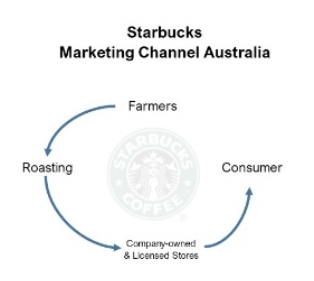
Figure 3 Starbucks Marketing Channel in Australia
2.4 Promotion
Promotion refers to the act or communication to build and maintain relationships, by informing and persuading one or more audiences; to stimulate demand, encourage product trial, retain loyal customers and combat competitor offers and reduce sales fluctuations (Pride et al., 2018). Starbucks engages in an Integrated Marketing Communications (IMC) approach, where it tries to coordinate and control the various elements of its promotional mix – advertising, personal selling, public relations, direct marketing and sales promotion – to produce a unified customer-focused message, and therefore, brand their product and achieve its company goals and objectives (Mangold & Faulds, 2018; Pride et al., 2018). Significantly, Starbuck uses emotional appeal in its advertising, which is a style of conveying promotional messages to stimulate emotions consumer’s emotional response through emotions such as humour, curiosity, excitement, happiness etc. (Pride et al., 2018; Zhang, Sun, Liu & Knight, 2014)
Starbucks primary promotional channels are:
Advertising
Starbucks promotes its products mainly through advertising, which Pride et al. (2018) refers to as paid non-personal communication about an organisation and its products conveyed to a target audience through mass media, including TV, radio, the internet, newspapers, magazines, direct mail, outdoor displays and signs on vehicles. Until recently, Starbucks has not engaged in traditional advertising, believing their large store presence, the “Starbucks Experience” and word-of-mouth to be all the advertising they needed to create brand awareness, customer loyalty and patronage (Patterson, Scott & Uncles, 2010).
Starbucks’ total advertising spend for the 2017 Fiscal year was $282.6 million (Starbucks, 2017), with their primary advertising channels:
Using outdoor displays to advertise new products or sales promotions on its doors and windows – see the display posted below outside the Starbucks Queens Plaza Store.
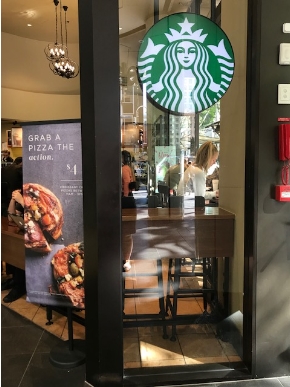
Social media platforms via the internet – recognising that consumers are now preferring social media over traditional sources of advertising like radio, tv and newspapers (Mangold & Faulds, 2009), Starbucks have invested and grown their online presence, becoming a huge social media brand with millions of followers and likes across all of their social media platforms including Instagram, Facebook, Twitter, Pinterest and YouTube. They use these social media platforms as their primary channel for advertising as well as to create brand awareness and engage with its customer base.
A review of Starbucks’s social media accounts portrays the effectiveness of their Integrated Marketing Communications. Their social media strategy focuses on providing engaging, relatable, inspiring, and more importantly, communicating consistent messaging and content for followers across all platforms. Moreover, Starbucks’ social media efforts not only raises brand awareness via news, events and promotions, but also serves as a customer service tool where it can encourage customer, questions comments and suggestions. As a result, consumers feel more engaged with Starbucks, contributing towards a sense of community in which honest and open communications are encouraged and customer engagement is enhanced (Mangold & Faulds, 2009).
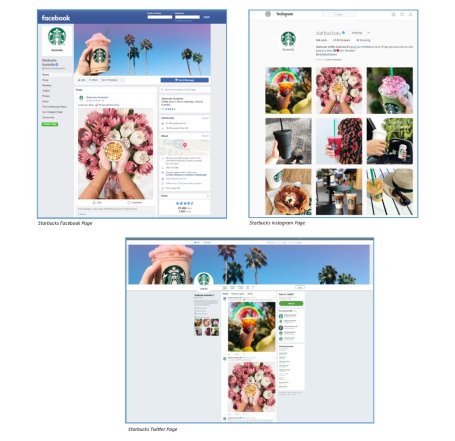
Across its social media accounts, it is evident that Starbucks adapts their content to fit each platform’s user experience. For example, on Facebook, Starbucks is multilingual to ensure it can reach and communicate with customers worldwide. On Instagram, Starbucks uses this platform well through the high definition photos and videos, with a clear focus on presenting their product to the public. They also use the stories feature of Instagram where they create sneak peeks of their newest products, post announcements and secret messages to get the coffee culture community excited. Notably, Starbucks has Australian accounts for Instagram and Facebook with consistent online posts and tailored to the Australian product offerings.
Consumer Sales Promotions
Consumer sales promotion encourage consumers to support specific retail stores or try particular products via coupons, vouchers, contests, free samples and bonuses (Pride et al., 2018). As part of their sales promotions, Starbucks Queens Plaza, occasionally offers free drink tasters to passersby on the streets to stimulate product trial, particularly for newly released beverages, and utilise the Starbucks Card that customers can use to get freebies (Starbucks, 2017).
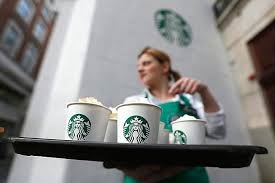
Product Placements
This is the strategic location of products or product promotions within TV programs or other entertainment media content to reach the product’s target market (Pride et al., 2018), see the following product placement examples:

Figure 4 Sex and the City movie
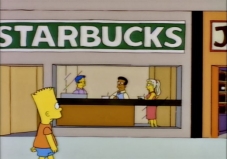
Figure 5 The Simpsons TV show
Note that these are US-based product placements, with Australian product placements non-existent (Patterson, Scott & Uncles, 2010).
Considering the above, it is important to acknowledge the changing media landscape. Despite the increase in adopting digital media, the challenge lies in capturing the attention of a multitasking target audience and their need for instant gratification (Pride et al., 2018). Overall though, from a global standpoint, Starbucks’s promotional mix is coordinated successfully, creating relationships with customers, engaging them long-term and impacting word of mouth, particularly via digital marketing channels, which are an effective choice of marketing communication is also effective when targeting the university student market segment who have high social media usage (Despinola, 2018). More importantly, there is an evident gap in promotional efforts in Australia, thereby, impacting brand awareness, sales, and the ability for the Starbucks to achieve its corporate goals and objectives of global expansion.
2.5 Physical Evidence
An important part of customer service is the physical environment. Because coffee shops like Starbucks provide intangible services along with their products, customers often rely on tangible cues, or physical evidence, to assess the service before its purchase and to evaluate their satisfaction with the service during and after consumption (Dado and Rajic, 2013; Pride et al., 2018). The physical evidence is the environment in which the service is delivered and in which the company and customer interact, and includes both tangible and intangible components that facilitate performance or communication of the service such as building design, decor, overall ambience, background music and staff presentation (Dado and Rajic, 2013; Pride et al., 2018). The physical facility or manmade physical surrounding is often referred to as the ‘servicescape’ and is important as it portrays an image of the company’s total offering (Dado and Rajic, 2013). Atmospheric variables form part of this servicescape, which are made up of a set of tangible and intangible service ambient features, such as furnishings, architecture, music, colour, scents, temperature, etc., and are essential elements of service delivery because it provides tangible cues for customer service quality (Rajo & Dadic, 2013). Foster and McLelland (2015) suggests that atmospherics has been used to elicit a response from the consumer by using non-verbal communication, through the enrichment of the consumer’s experience, with the intent to extend the current visit and create the intention to return. In essence, it is an extension of a company’s brand and image.
Starbucks incorporates the concepts of servicescape and atmospheric variables whereby it attempts to design and tailor each of its store to meet customer needs and relating it to the local communities, the street, the city and the local coffee culture that it operates in (Starbucks US, 2018c). significantly, the coffee chain strives to provide a coffeehouse that is positioned as a “third place” away from home and work, where people can spend time and connect in a relaxed and comfortable environment that is welcoming, cosy, inviting (Patterson, Scott & Uncles, 2010). Essentially, Starbucks stores are designed to make customers stay longer, buy more, and return for another visit. As is the case for Starbucks Queens Plaza, the overall design and layout reflects the metropolitan city location albeit in a congested corner store front location as part of the bustling intersection of Edward and Adelaide Street.
Its servicescape/atmospheric variables are:
Exterior
- The store is shaped like a triangle – one side is facing Adelaide Street with a huge glass window, and then the other side is facing inside of the shopping centre, also with a huge glass window.
- There is a large Starbucks signage facing Adelaide Street.
- It has entrances both from inside the shopping centre and outside the main front walk facing Adelaide Street.
General Interior & Store Layout
- Overall store cleanliness is average
- It has terracotta coloured tiled floors
- Low / bar-like tables are lined up against the windows facing Adelaide Street and the shopping centres. A further combination of high-set and low-set tables are scattered throughout the store, coupled with wooden chairs.
- There is standard lighting as natural lighting from outside is maximised through the large windows.
- There is also a large display case for merchandise such as coffee beans and coffee mugs in the middle of the store as well as by the street-facing entrance on the right-hand side of entry.
- There are large menu boards placed high behind and above the counter
- There is a food display case on the right side of the counter, with the coffee-making station and “delivery” station on the left-hand side towards the entrance from the shopping centre side.
- There is no designated waiting area, so customers generally wait near the delivery table side by the shopping plaza entrance.
Employees
- Employees are seen wearing all black, paired with their signature green Starbucks aprons.
Music
- Music is playing in the overhead speakers, with no noticeable music theme
Miscellaneous
- Free Wi-Fi available for usage in-store using password provided
- Power points available for charging electronic devices, although only limited number are available.
Although the Starbucks Queens plaza design has a modern feel to it, it is still somewhat a standardised store design with lack of differentiating character and poor servicescape and atmospherics. It does not feel like the store is tailored to the specific location or city like it claims to strive for and it does not fully cater to the target market segment of university students. The coffee store itself is congested with poor customer flow (ordering and waiting for order), and there is a lack of comfortable seating options such as couches to achieve the “third place” feel. Therefore, the physical evidence element is significantly inconsistent with the other aspects of the marketing mix – particularly price, where it is difficult to justify prestige or high prices for a “high quality” coffee house that is supposed to have both the quality coffee and excellent servicescape.
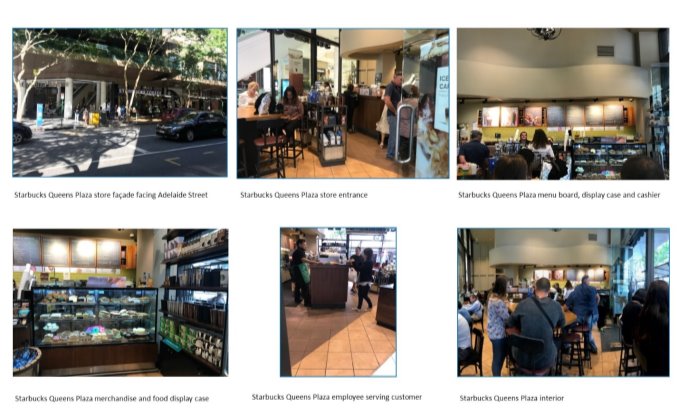
Figure 6 Starbucks Queens Plaza Store – Physical Evidence & Servicescape
2.6 Processes
Processes in the expanded marketing mix refers to the flow and progress of customers when they engage with the product and company (Pride et al., 2018). The typical ordering process at Starbucks store can look like the following:
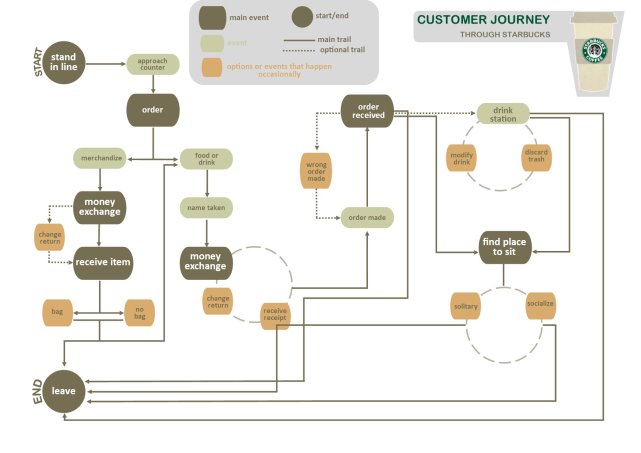
Figure 7 Typical customer journey in a Starbucks store
In relation to processes, Starbucks uses technology-related initiatives to value-add and improve its customer journey process. The most notable example is its recent launch of its Mobile Order & Pay feature. Recognising that customer waiting time impacts customer satisfaction, quality perception and customer loyalty (La Monica, 2017; Pride et al., 2018), Starbucks in the US has introduced mobile order-ahead apps, which are consumer-facing mobile payment platform that allows customers to order food remotely, pay for the items on their phone, and pick up their order at a specific store location (BI Intelligence, 2016; Peterson, 2017). This has led to increased sales, customer loyalty, and foot traffic. Unfortunately, digital initiatives in Australia are not quite as advanced, with Starbucks only having in place an iPhone-compatible mobile App where customers can pay quickly via phone scanning as well using the app to register and manage their Starbucks Card and find the closest store (Starbucks Australia, 2018e). Although this to a certain extent does help enhance the customer experience and quicken the customer flow at point of sale, it does little to address customer waiting times or help in successfully providing the “The Starbucks Experience” in terms seamless digital experience, like its US counterparts. This does not go to show though that Starbucks doesn’t have any mechanisms in place – when waiting lines are long, another Starbucks employee simply takes orders directly from customers still waiting in line to be served. Although this isn’t as sophisticated as a digital app, it maintains the human connection and encourages dialogue. (Pride et al., 2018; Sheu, McHaney & Babbar, 2003).
2.7 People
The people variable refers to the human aspect of products, services or experiences and includes those people involved with producing the product and offering the service or experience, as well as other fellow customers, employees and passersby who share the customer service experience – an element that plays a critical role in overall quality perception of the company and its products (Pride et al., 2018).
Starbucks employees are referred to as “Starbucks Partners” and are required to undergo weeks of training – not just to learn how to make coffee, but to understand the nuances of the Starbucks brand and how to deliver on its promise of the Starbucks Experience (Patterson, Scott & Uncles, 2010; Starbucks Australia, 2018c). There is also an expectation of Starbucks employees to exhibit emotional labour, which is when employees are expected to engage with the customer and to make personal or emotional connection with them, leading to satisfied customers and an enhanced in-store experience (Pride et al., 2018). However, in response to intense competition in the coffee industry, Starbucks Australia introduced sales key performance targets for front-line employees, where staff and baristas have less time to engage with customers and instead focusing on serving ‘x’ number of customers per hour (Patterson, Scott & Uncles, 2010). As a result, the coffee chain has strayed from the core values that the brand is founded on and promotes, leading to a diminished in-store experience and once again, the inability unable to meet its corporate objectives of providing the renowned “Starbucks Experience” – which the people element is a huge part of. Also, even though Starbucks customers are satisfied at least at the customer service level, they are still able to seek this level of service elsewhere, if not better, as customer service is easily imitable by competitors and therefore, is not differentiated in this regard.
2.8 Partnerships
Partnerships refer to alliances formed between organisations that have complementary skills or assets, or lack of resources or expertise, with joint goals to meet company objectives and customer needs or enhance business performance (Pride et al., 2018).
For example, Starbucks has partnered with Spotify that allows members of the Starbucks reward program to influence the songs that play when they are in the store (Billboard, 2016; Stevenson, 2015). Similarly, earlier this year, Nestle and Starbucks entered into an alliance where the Swiss food and beverage company pledged to pay Starbucks $7.15 billion for exclusive rights to sell the US-based chain’s coffees and teas around the world, giving the coffee chain access to a new markets such as China (Bloomberg News, 2018). These examples suggest that for Starbucks, partnerships are formed on the global scale, or is US-based, rather than nationally in Australia, which limits its access to local knowledge, resources and expertise.
3. Recommendations
The evaluation of Starbucks Queens Plaza’s marketing mix and the recommendations that follow are largely underpinned by the need for the coffee chain to differentiate itself from competitors, to modify existing marketing strategies relative to target market segments and address the many contemporary issues identified in Section 1 of this report. A few key recommendations are as follows:
STARBUCKS QUEENS PLAZA RECOMMENDATIONS
Product
Because Starbucks’s products are at the growth stage of the product life cycle and approaching maturity, brand differentiation and feature diversification is integral to maintaining and increasing market share. At the core of this, Starbucks Queens Plaza will need to better understand the Australian coffee culture and the market segment (university students). It can do so by speaking to the customers from this market segment directly, conducting targeted surveys or using their very own crowdsourcing platform, My Starbucks Idea, to innovate and improve their products and services. This platform encourages customers to submit ideas for better products, ways to improve the customer experience, and allows customers to provide feedback on what they want (Hossain & Islam, 2015). Although this platform is open to anyone who signs up to website and submit their own ideas or vote and comment on ideas submitted by other people, this could perhaps be promoted more within Australia for localised and relevant feedback.
With this knowledge and insight, Starbucks Queens Plaza can then:
Focus on and improve the quality of its product mix through line extensions and product modifications (Pride et al., 2018; Vuong, 2018). For example, Patterson, Scott & Uncles (2010) suggest that Australian coffee drinkers prefer stronger sophisticated coffee with less syrup so perhaps introducing a product line of stronger brewed coffee. Further, to cater to its market segment, Starbucks Queens Plaza could consider introducing ready to drink / bottled coffee beverages for students who are on the go and wanting that caffeine hit, similar to the US who has a bottled drink line (Starbucks US, 2018b). Starbucks Australia can also consider introducing similar product offerings to that of Starbucks’s premium coffee house, Starbucks Reserve (Kell, 2016). In turn, this will achieve greater market penetration, satisfying the needs of people in several different market segments.
Continue to capitalise on consumer preferences and trends – given the rising trend in health consciousness, ethical consumerism and an increased focus on product provenance, Starbucks should continue to invest in and promote its existing ethical sourcing practices and environmental stewardship initiatives (Starbucks, 2018b). This includes their fair-trade coffee which Starbucks can charge a premium price for, thereby, contributing to revenue increase as well (Vuong, 2018).
Price
As discussed in Section 1.1, Australian coffee drinkers consider Starbucks coffee to be of inferior quality compared to other coffee houses and are also able to get the same “third place” experience at other boutique cafes (Patterson, Scott & Uncles, 2010). Therefore, to maintain and complement Starbucks’s premium pricing strategy and justify its high prices to current and potential customers, it will need to invest significantly in improving its product quality, introducing relevant product lines, improving its servicescape coupled with providing a seamless digital experience.
Moreover, once the marketing mix elements have been addressed, it is imperative for Starbucks to promote its prestige pricing benefits – Starbucks does not just sell coffee but an entire experience built around the concept of luxury and ethically, environmentally sourced products; great customer service and a unique servicescape. Once these elements have been improved on and promoted, Starbucks customers will be insensitive to the price difference between its products and the competing ones, thereby sustaining both a premium pricing strategy and a premium image.
Place
On a global scale, this element of Starbucks’s marketing mix is executed effectively and efficiently. The coffee chain’s centralised distribution channel and overall supply chain is not only influenced by its need to control quality, but it is also underpinned by its goal to be ethically and globally responsible. However, in Australia, Starbucks should follow suit with the US stores and implement a hybrid marketing channel instead of a direct marketing channel only. Using multiple distribution channels will allow the company to reach a wider market, increase sales, and ultimately, achieve its global expansion objective. (Pride et al., 2018).
Promotion
On a global scale, Starbucks’s promotional mix is executed effectively and successfully, capitalizing on social media and doing it very well. However, the promotional activities that they are renowned for overseas should be launched (and tailored) in Australia and can include:
- Like the US, Starbucks Australia can partner with popular Australian YouTube sensations or even local celebrities to promote its brand (Riggins, 2016).
- Engage in traditional forms of advertising such as television and radio to reach a broader market. To target university students, it could advertise via university newspapers and radio stations, and even posters.
- Hold contests and promotions targeted at university students to promote brand awareness, encourage product trial and increase sales (Pride et al., 2018). For example, in the US, Starbucks posted new advertising posters in six major cities in the U.S. where people had to take a picture of them and Tweet it, with winners receiving a store gift card worth $20 (McNamara & Moore-Mangin, 2015). Starbucks Queens Plaza can apply this idea locally and target university students for the competition. In turn, the campaign can generate lots of interest and increase brand awareness.
- Engage in local sponsorships to develop a market presence. For example, sponsoring Brisbane universities such as Queensland University of Technology (QUT) for sports events. This in turn will align with Starbucks’s goal and commitment to supporting its local communities (Starbucks Australia, 2018a).
Processes
According to Sheu, McHaney & Babbar (2003), any reductions in customer waiting time by better management of process design can lower both customer dissatisfaction and defection. As such, to improve processes, Starbucks Australia can implement the following:
- Introducing mobile order-ahead apps to reduce the impact of long waiting times like Starbucks US’s recent launch. This will enable consumers to remotely purchase menu items for in-store pickup (BI Intelligence (2016). This can in turn increase customer loyalty and purchase frequency and lift average ticket sizes through order customization and easier checkout options (BI Intelligence (2016). Note that this shouldn’t replace in-store purchasing, but a channel that can enhance the customer journey.
- Another initiative is implementing a “create your own drink” kiosk, similar to that of McDonald’s famous “Create Your Taste” kiosk where customers use a touch screen kiosk to create their own burger (Brandy, Peterson & Johnson, 2016). This not only enhances customer involvement and satisfaction, but Starbucks can also use this as insight into customer tastes and preferences.
- Making Starbucks partners/employees accountable for “delivery” times, like the Domino’s Pizza 20-minute delivery guarantee (Domino’s, n.d.). If a customer hasn’t received their drink, say after 10 minutes, then the waiting customer will receive a free drink voucher for next time or even a small food item for compensation. Not only does this reduce customer frustration, it can help retain customers in the long run.
Such initiatives could therefore enhance store efficiency, enhance customer satisfaction and experience.
People
Instead of implementing various sales KPTs (key performance targets) for Starbucks partners, behaviour-based objectives or goals should be applied as part of Starbucks’s performance management framework. For example, a Starbucks employee can be measured against their demonstration of Starbucks core values such as (Starbucks US, 2018):
- Dignity and respect – being present, connecting with transparency
- Acting with courage, challenging the status quo
- Creating a culture of warmth, belonging and welcoming everyone
Physical Evidence
Starbucks needs to enhance its in-store experience or “third place” as part of its “Starbucks Experience” offering. The offering is no longer a differentiating factor as it can be easily copied by its competitors and does not complement its prestige pricing strategy as identified earlier. To do this, the coffee store should:
Foster and McLelland (2015) suggest that rather than making decisions regarding each individual atmospheric elements in isolation such as lighting, furniture, music etc., the coffee chain could take on a more holistic approach to the elements and provide a more multisensory coffee consumption experience for students. A themed retail environment for example can create a more differentiated, interactive, and immersive customer experience, leading to more positive marketing outcomes such as consumer enjoyment and loyalty (Foster and McLelland, 215). Taking on this approach, Starbucks Queens Plaza can incorporate perhaps a modern yet warm library theme – with comfortable chairs and lounges, ample lighting, technology hubs where students can charge their laptops, phones and tablets etc. Although satisfaction is not directly influenced by atmospherics, store ambience shape customer service quality perceptions, which further leads to satisfactory experience (Rajo & Dadic, 2013).
Building on those high-concept stores, Starbucks Queens Plaza can also look at converting the coffee store to a coffee bar for the evenings, accommodating for late night studies and meet ups amongst friends. This would be like Starbucks’s Reserve concept store open in select cities worldwide – it is an espresso bar that makes coffee using a greater variety of brewing methods compared to the typical Starbucks store (Kell, 2016). This bar experience is more exotic, engages the customer and comes with higher price This, this allows for a more for the creation of more diverse experiential retail environments that can have a positive impact on the consumer–brand relationship (Foster & McLelland, 2015).
Partnerships
Although globally Starbucks has solid business partnerships and alliances as identified in Section 1.8, the company needs to leverage the expertise of Australian local partners and businesses. For example:
In the US, Starbucks has partnered with bookstore chain Barnes & Noble, which saw Starbucks open locations inside Barnes & Noble locations, giving readers and shoppers a reason to hang out in the store – and giving Starbucks an avenue into an established retailer (Zaidi, 2017). Subsequently, Starbucks can strike a similar arrangement with leading bookstore, Dymocks, targeting not only avid readers, but also the university students which are very much their target market (Zaidi, 2017). Or Starbucks can strike an arrangement with David Jones in Queens Plaza and open an in-house coffee lounge serving Starbucks coffee. Such a strategic alliance can mean increased market reach, presence, and sales.
Partner with Translink, Queensland’s public transport provider, and target university / concessional students where for every 4th or 5th ride, students receive a 50-cent discount off Starbucks coffee purchases.
Partner with university-central businesses such as Student VIP or even the university bookshops, providing similar discounts for purchases or memberships.
These examples in turn reaches a wider market, builds presence and brand awareness, and ultimately contributes towards the achievement of its corporate objectives
4. Conclusion
In summary, although Starbucks is a successful global brand with its extended marketing mix aligned to its corporate objectives and goals, this is only so at the US level. It is evident that there is a considerable gap between US and Australia store operations where today’s current state reveals a real lack of differentiation from its competitors; poor brand communication and awareness; an inconsistency in providing an authentic “Starbucks Experience” coupled with negative customer-perception of value in relation to its prestige pricing. Thus, to thrive in the intense industry it operates, it is imperative for Starbucks, to firstly develop a deeper understanding of the sophisticated and established Australian coffee culture. Consequently, with this foundational knowledge, the coffee chain can better tailor its operations and extended marketing mix to the unique Australian context instead of applying the impersonal, global chain experience that many Australian consumers have experienced or perceive it to be. This, coupled introducing US-based store initiatives, particularly digital-innovations, can help Starbucks to position itself as a prestige/luxury and advanced coffee store in the market relative to its competitors. Once these issues are addressed in the marketing mix, the coffee chain can attempt to differentiate more effectively; build and awareness and loyalty; increase sales, and ultimately, enabling the coffee chain to achieve its corporate objectives in Australia.
5. References
BI Intelligence. (2016). Starbucks’ five year plan leans heavily on digital. Retrieved from http://www.businessinsider.com/starbucks-five-year-plan-leans-heavily-on-digital-2016-12/?r=AU&IR=T
Billboard. (2016). Starbucks announces Spotify partnership, app integration. Retrieved from https://www.billboard.com/articles/business/6844194/starbucks-spotify-partnership-app-integration
Bloomberg News. (2018, May 16). Flush with Nestle Cash, Starbucks unveils bold China Plan. Retrieved from https://www.bloomberg.com/news/articles/2018-05-16/flush-with-nestle-cash-starbucks-wants-to-triple-china-revenue
Brandy, D., Peterson, H., & Johnson, H. (2016). McDonald’s dumped ‘Create Your Taste’ in the US but it’s staying in Australia and even coming to the drive-through. Retrieved from https://www.businessinsider.com.au/mcdonalds-dumped-create-your-taste-in-the-us-but-its-staying-in-australia-and-even-coming-to-the-drive-through-2016-11
Despinola, C. (2018). 2018 digital report – Australia. Retrieved from https://wearesocial.com/au/blog/2018/02/2018-digital-report-australia
Dodds, W. B., Monroe, K. B., & Grewal, D. (1991). Effects of price, brand, and store information on buyers’ product evaluations. Journal of Marketing Research, 28(3), 307. Retrieved from https://search-proquest-com.ezproxy.csu.edu.au/docview/235232811?accountid=10344
Domino’s. (n.d.). Domino’s delivery guarantee. Retrieved from https://www.dominos.com.au/inside-dominos/technology/delivery-guarantee
Foster, J., & McLelland, M, A. (2015). Retail atmospherics: the impact of a brand dictated theme. Journal of Retailing and Consumer Services, 22, 195-205. Retrieved from https://doi.org/10.1016/j.jretconser.2014.07.002.
Hossain, M., & Islam, K. M. Z. (2015). Generating ideas on online platforms: A case study of ‘My Starbucks Idea”. Arab Economic and Business Journal, 10, 102-111. Retrieved from http://dx.doi.org/10.1016/j.aebj.2015.09.001
Kell, J. (2016a). Starbucks’ sales jump leads to confidence in high-end coffee strategy. Retrived from http://fortune.com/2016/11/03/starbucks-premium-coffees/
La Monica, P, R. (2017). Starbucks still has a problem with long lines. Retrieved from http://money.cnn.com/2017/01/27/investing/starbucks-long-lines-mobile-ordering-earnings/index.html
Mangold, G, W., & Faulds, D, J. (2009). Social media: the new hybrid element of the promotion mix. Business Horizons, 52 (4), 357-365. Retrieved from https://doi.org/10.1016/j.bushor.2009.03.002.
McNamara, T. & Moore-Mangin, A. (2015). Starbucks and social media: it’s about more than just coffee. Retrieved from http://www.econtentmag.com/Articles/Editorial/Commentary/Starbucks-and-Social-Media-Its-About-More-than-Just-Coffee-103823.htm
Patterson, P. G., Scott, J., & Uncles, M. D. (2010). How the local competition defeated a global brand: The case of Starbucks.” Australasian Marketing Journal (AMJ), 18(1), 41–47. doi:10.1016/j.ausmj.2009.10.001.
Peterson, H. (2017).“Starbucks is testing a new technology to solve its crisis of long lines and delays. Retrieved from: http://www.businessinsider.com/starbucks-sends-text-messages-to-fix-long-lines-in-stores-2017-3
Pride, W. M., Ferrell, OC., Lukas, B. A., Schembri, S., Niininen, O., & Casidy, R. (2018). Marketing Principles: 3rd Asia Pacific Edition. South Melbourne: Cengage Learning Australia
Rajic, T., & Dado, J. (2013). Modelling the relationships among retail atmospherics, service quality, satisfaction and customer behavioural intentions in an emerging economy context. Total Quality Management & Business Excellence, 24(9/10), 1096-1110. Retrieved from http://dx.doi.org/10.1080/14783363.2013.776759
Riggins, N. (2016). Starbucks demonstrates influencer marketing with YouTube star coffee taste test. Retrieved from https://smallbiztrends.com/2016/10/influence-marketing-example.html
Sheu, C., McHaney, R., & Babbar, S. (2003). Service process design flexibility and customer waiting time. International Journal of Operations & Production Management, 23(7), 901-917. Retrieved from https://search-proquest-com.ezproxy.csu.edu.au/docview/232326343?accountid=10344
Starbucks. (2017). Starbucks fiscal 2017 annual report. Retrieved from https://s22.q4cdn.com/869488222/files/doc_financials/annual/2017/01/FY17-Starbucks-Form-10-K.pdf
Starbucks Australia. (2018a). Community Involvement. Retrieved from https://www.starbucks.com.au/Community-Involvement.php
Starbucks Australia. (2018b). Global responsibility. Retrieved from https://www.starbucks.com.au/Global-Responsibility.php
Starbucks Australia. (2018c). Learning & development. Retrieved from https://www.starbucks.com.au/Learning-Development.php
Starbucks Australia. (2018d). Our menu. Retrieved from https://www.starbucks.com.au/Menu.php
Starbucks Australia. (2018e). Starbucks Australia Mobile App. Retrieved from https://www.starbucks.com.au/Starbucks-Australia-Mobile-App.php
Starbucks Australia. (2018f). Starbucks in Australia. Retrieved from https://www.starbucks.com.au/Starbucks-in-Australia.php
Starbucks Australia (2018g). The Starbucks experience. Retrieved from https://www.starbucks.com.au/The-Starbucks-Experience.php
Starbucks US. (2018a). Starbucks company profile. Retrieved from https://www.starbucks.com/about-us/company-information/starbucks-company-profile
Starbucks US. (2018b). Starbucks drinks. Retrieved from https://www.starbucks.com/menu/drinks
Starbucks US. (201c). Store design. Retrieved from https://www.starbucks.com/coffeehouse/store-design
Starbucks US. (n.d.). Fact sheet: Starbucks and PepsiCo partnership. Retrieved from https://news.starbucks.com/facts/fact-sheet-starbucks-and-pepsico-partnership
Stevenson (2015). Starbucks CEO on Spotify: more partnerships coming. Retrieved from https://www.cnbc.com/2015/05/18/starbucks-ceo-on-spotify-more-partnerships-coming.html
Vuong, B. (2018). IBISWorld Industry Report H4511b. Cafes and Coffee Shops in Australia. Retrieved from IBISWorld database
Zaidi, F. (2017, Aug 3). Strategic partnerships can be a game change for your small business. Retrieved https://www.theglobeandmail.com/report-on-business/small-business/sb-marketing/strategic-partnerships-can-be-a-game-changer-for-your-small-business/article35854479/
Zhang, H., Sun, J., Liu, F., & Knight, J.,G. (2014). Be rational or be emotional: Advertising appeals, service types and consumer responses. European Journal of Marketing, 48(11), 2105-2126. Retrieved from DOI 10.1108/EJM-10-2012-0613
Zomato. (n.d.). Noosa Chocolate Factory menu. Retrieved from https://www.zomato.com/brisbane/noosa-chocolate-factory-2-brisbane-cbd/menu#tabtop
Appendix A
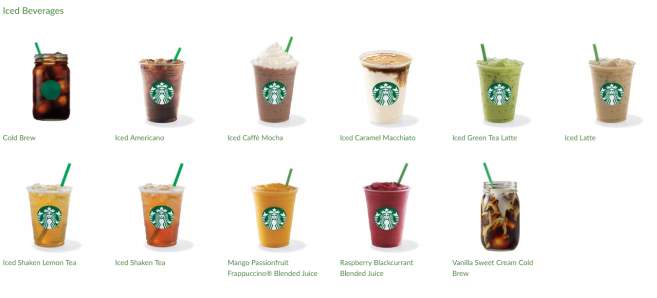

Starbucks Product Mix Australia
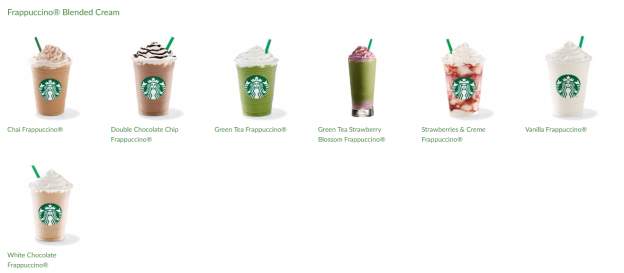

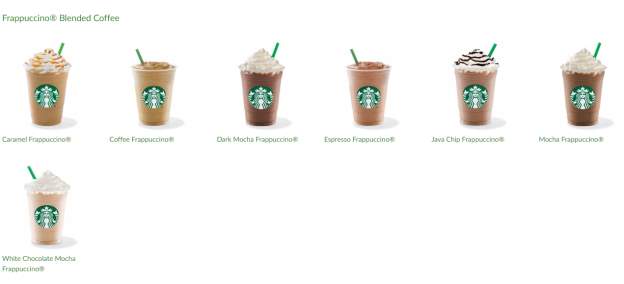
Cite This Work
To export a reference to this article please select a referencing stye below:
Related Services
View allRelated Content
All TagsContent relating to: "Business Strategy"
Business strategy is a set of guidelines that sets out how a business should operate and how decisions should be made with regards to achieving its goals. A business strategy should help to guide management and employees in their decision making.
Related Articles
DMCA / Removal Request
If you are the original writer of this dissertation and no longer wish to have your work published on the UKDiss.com website then please:




